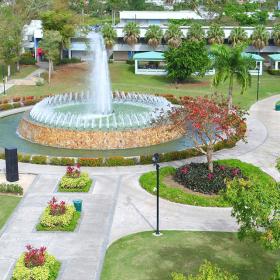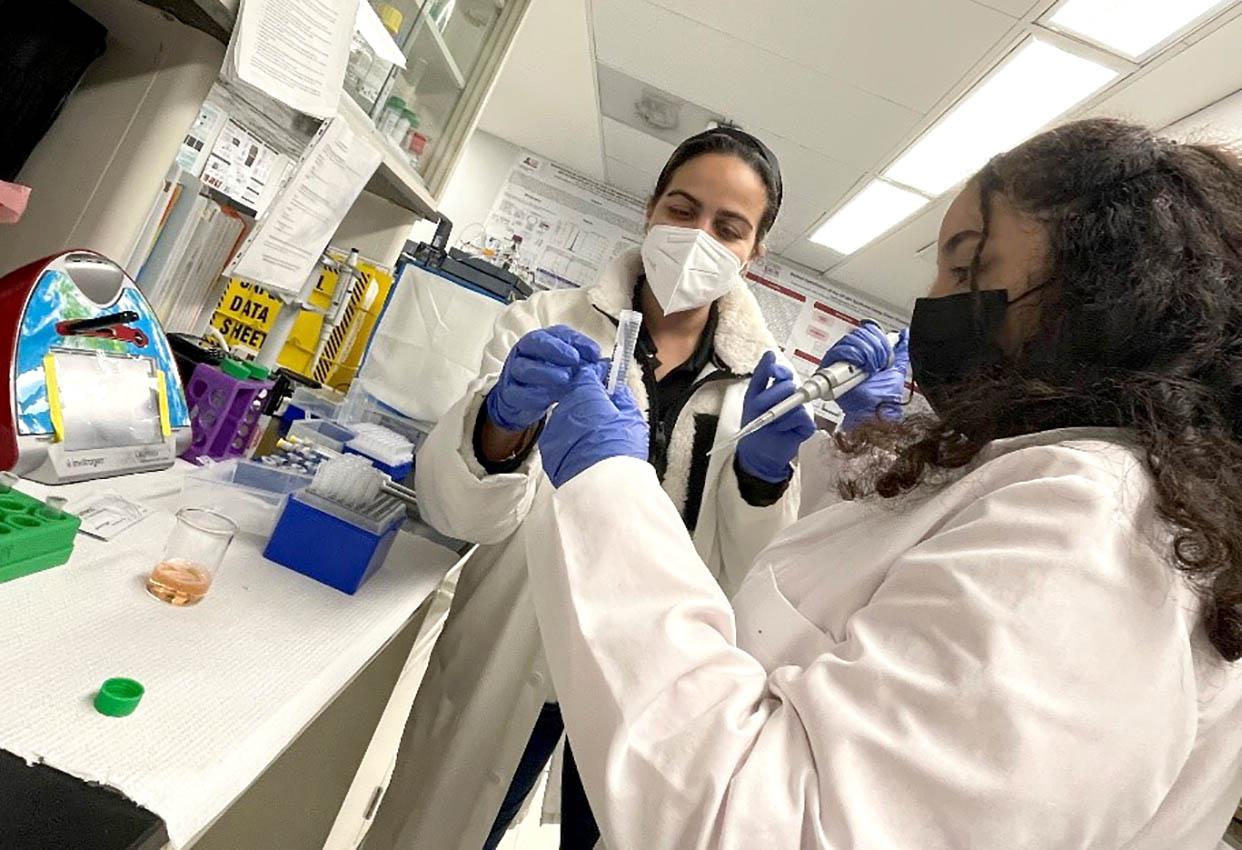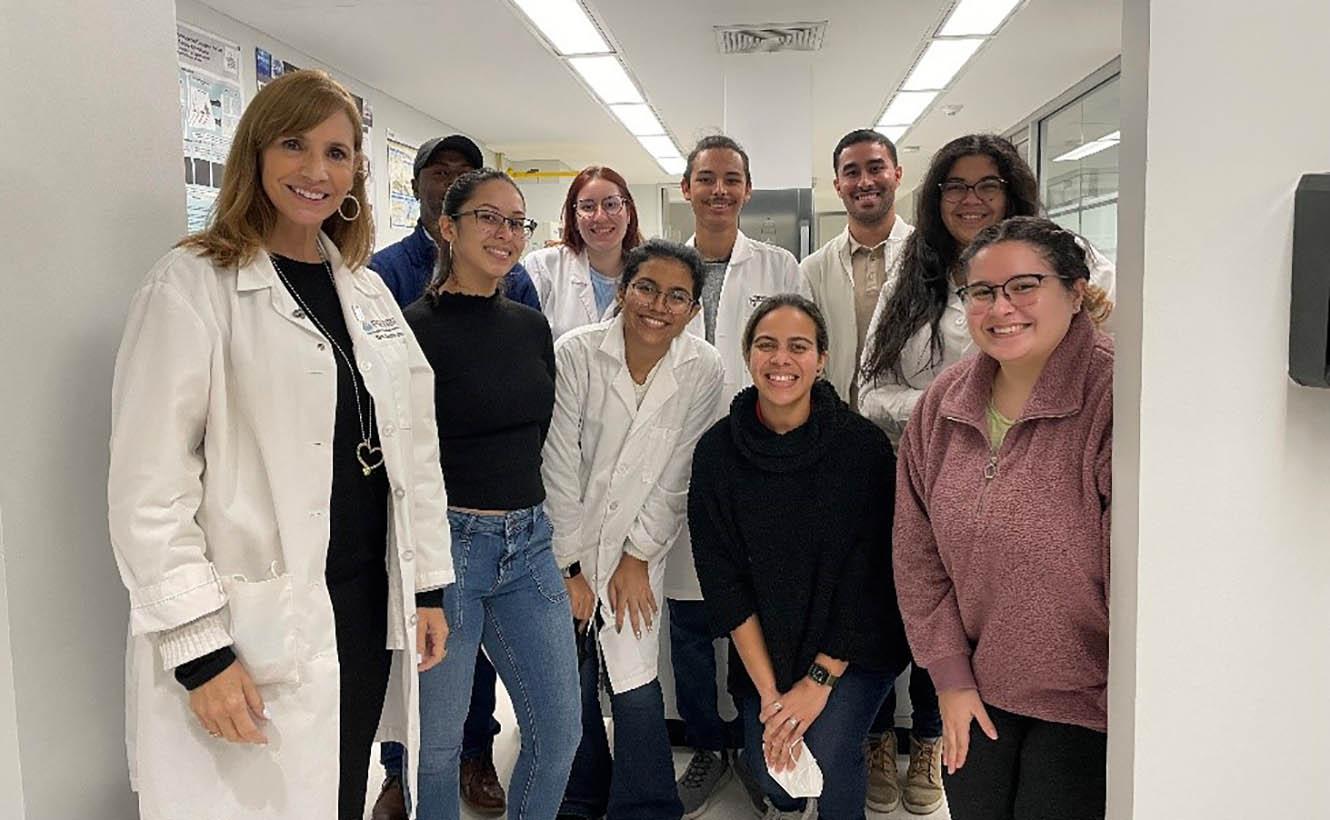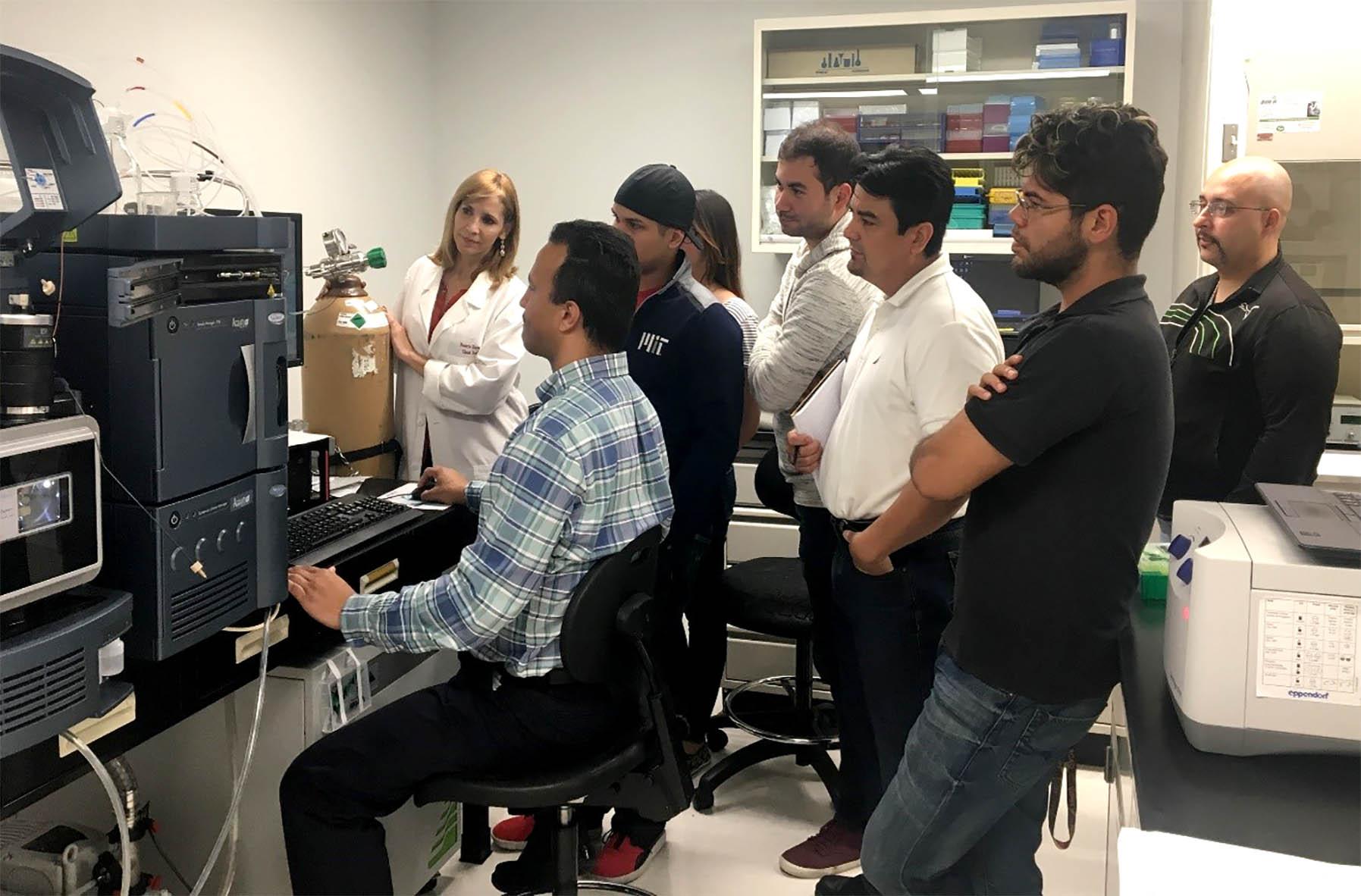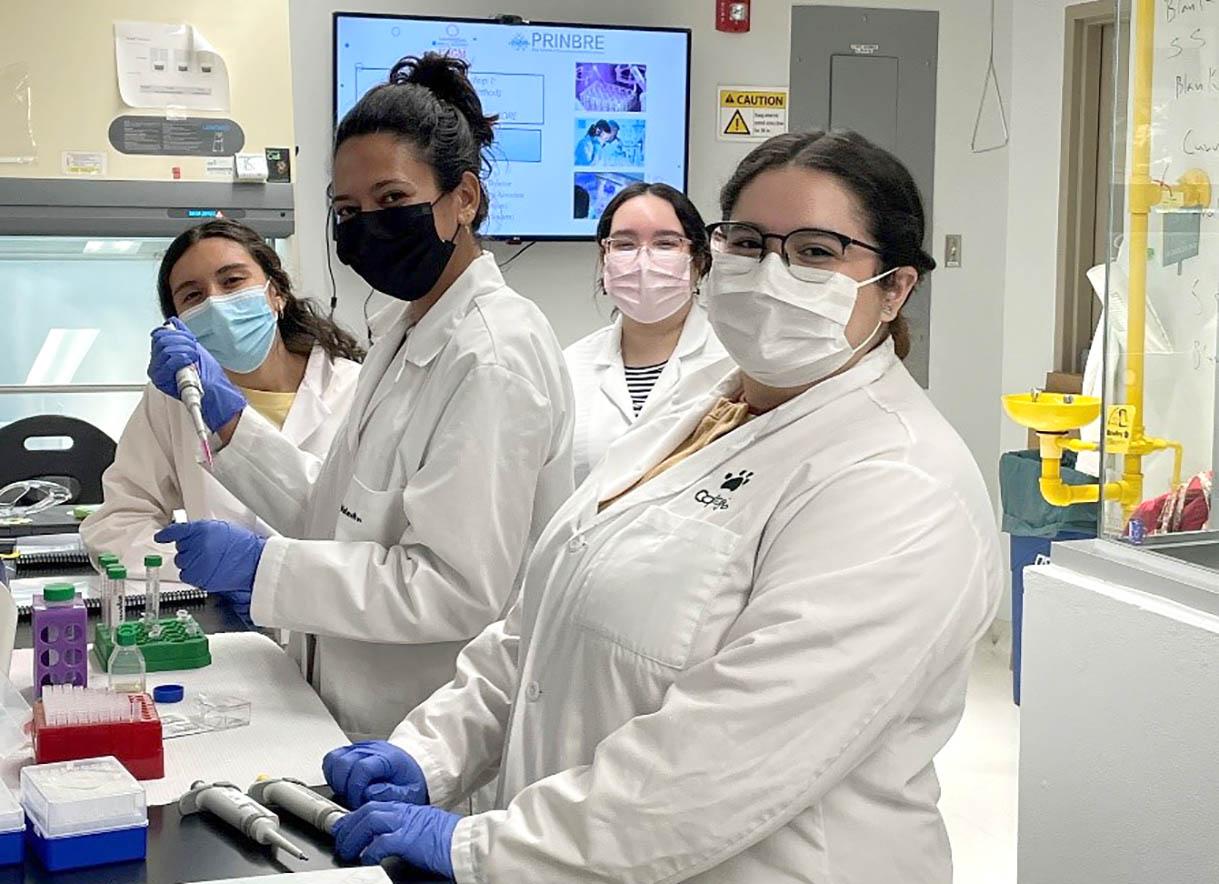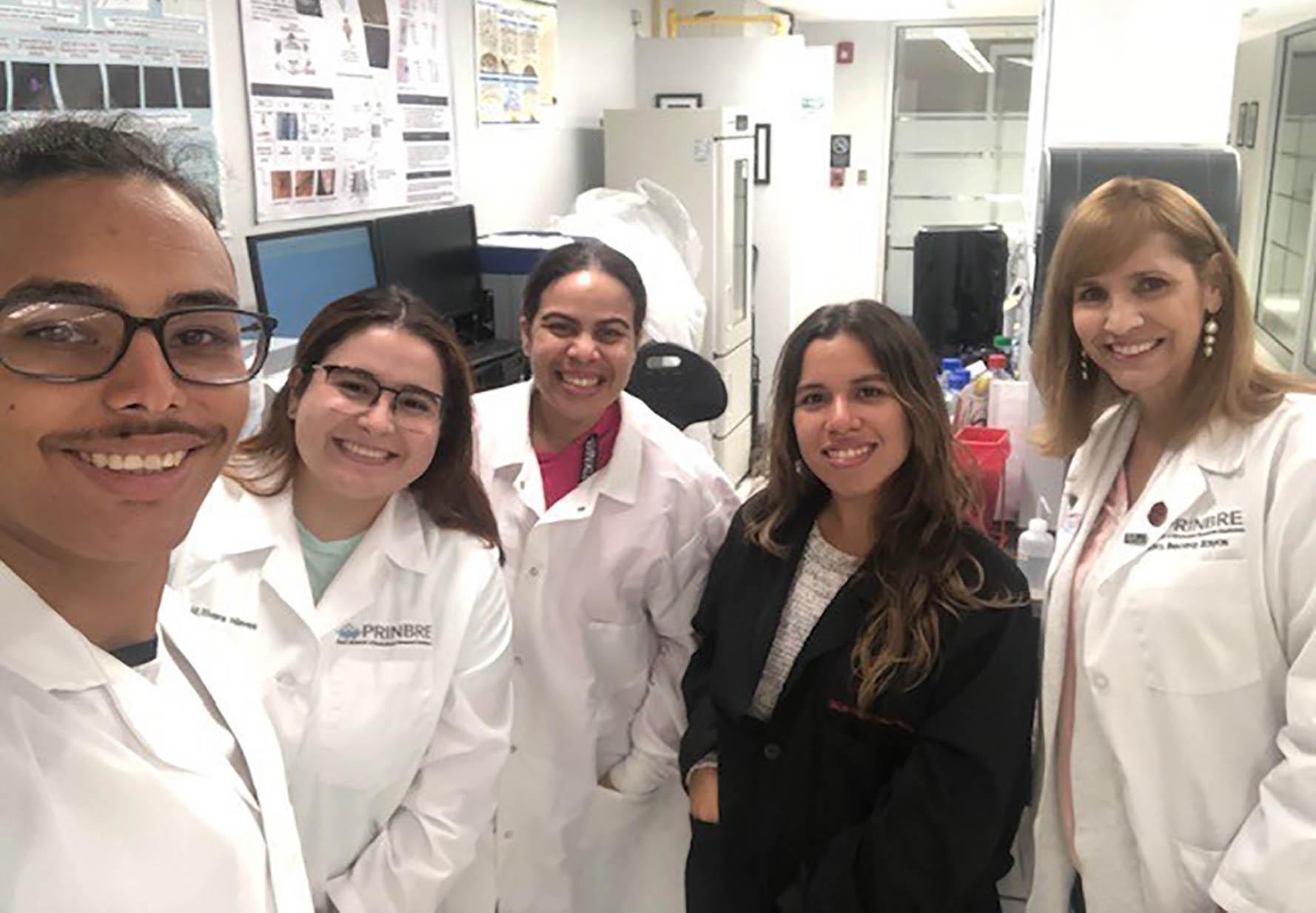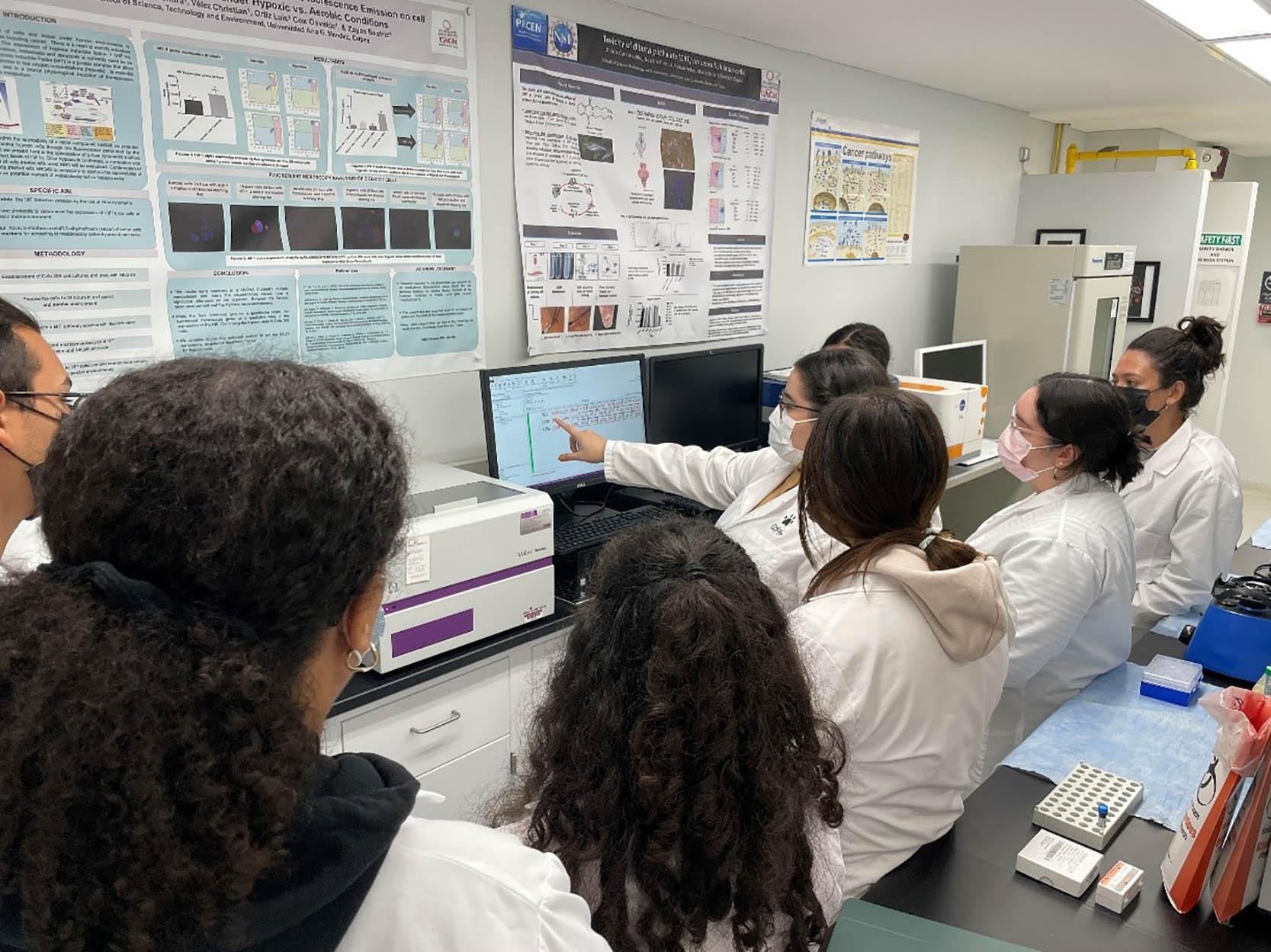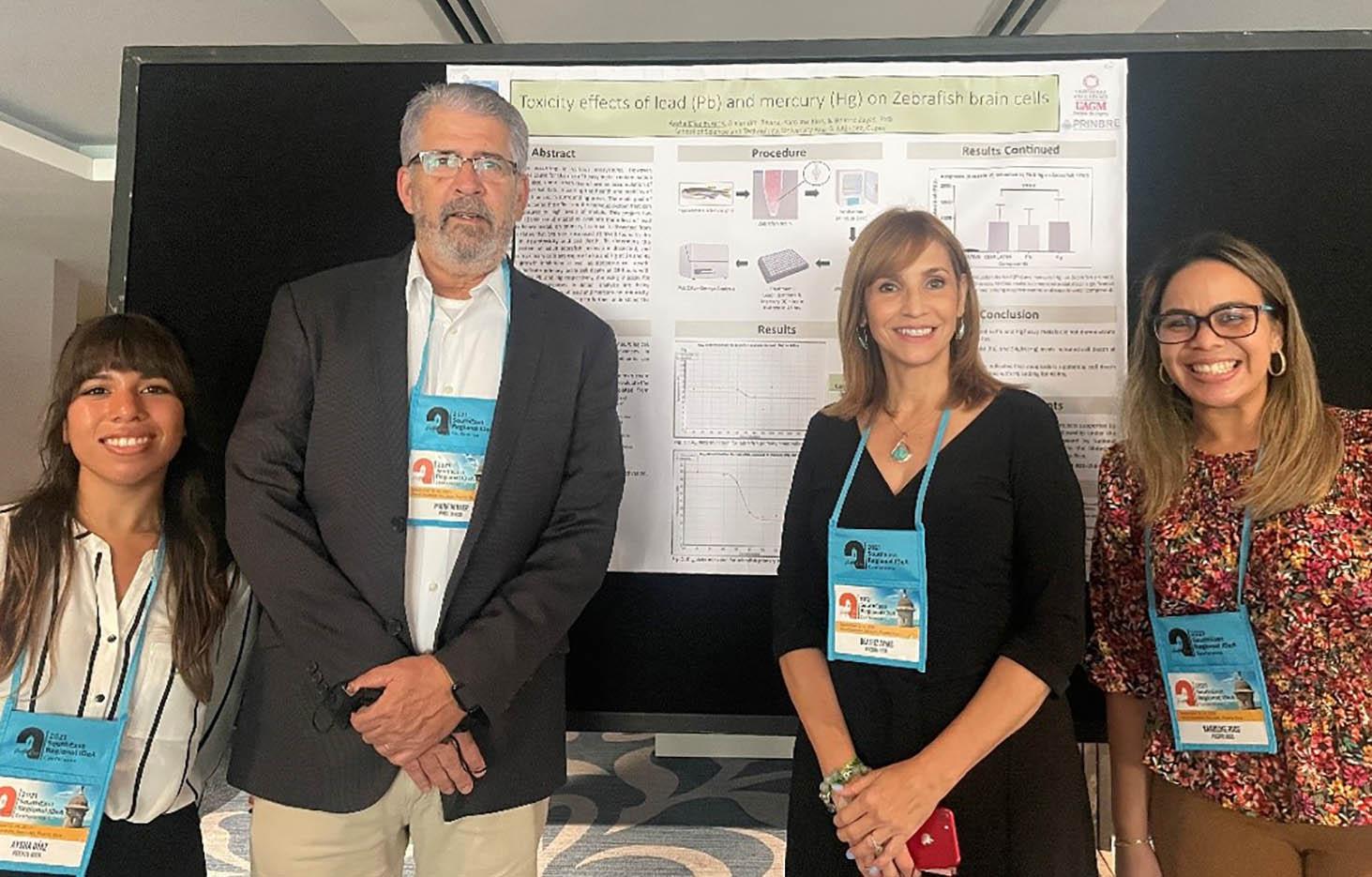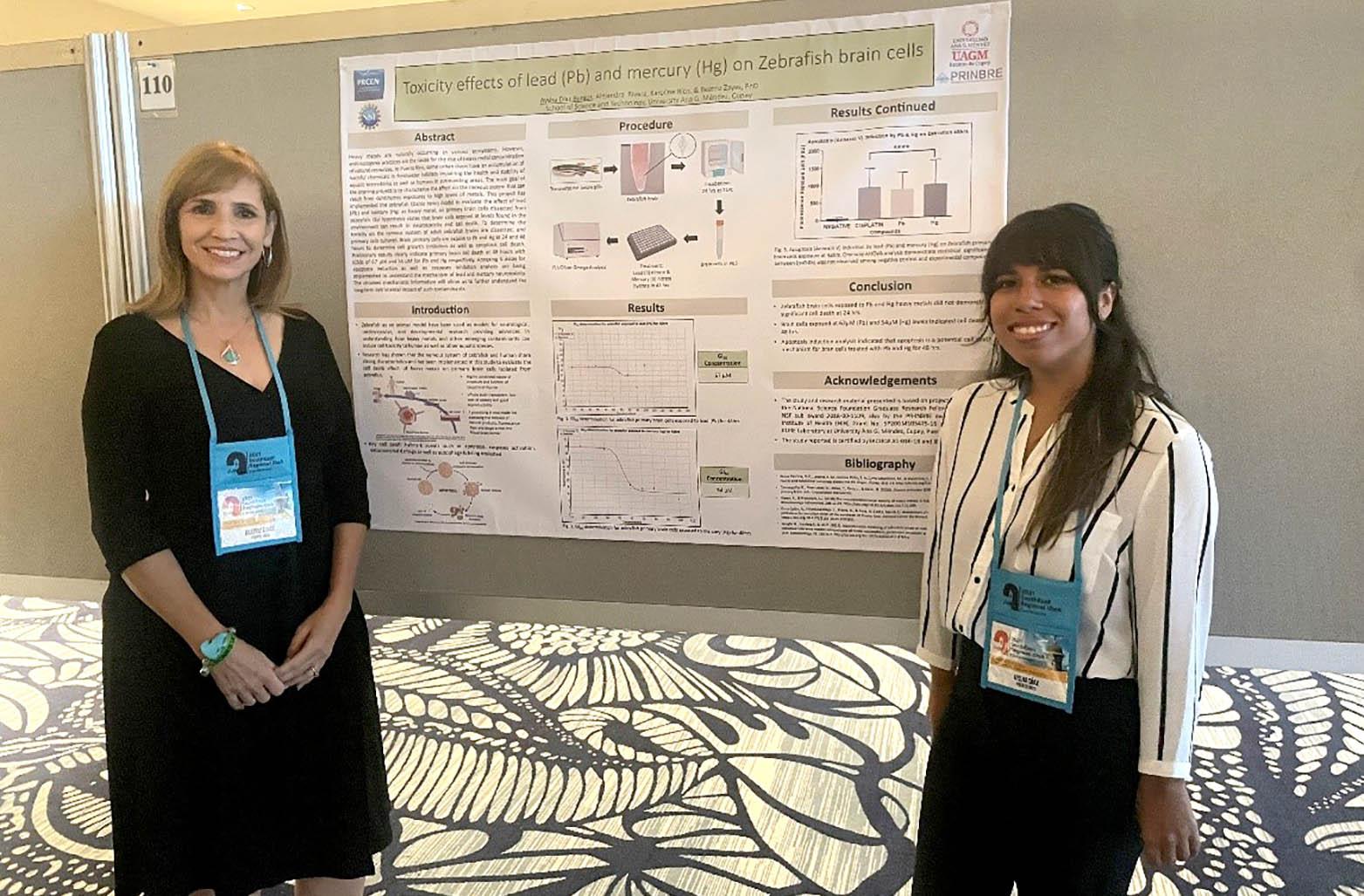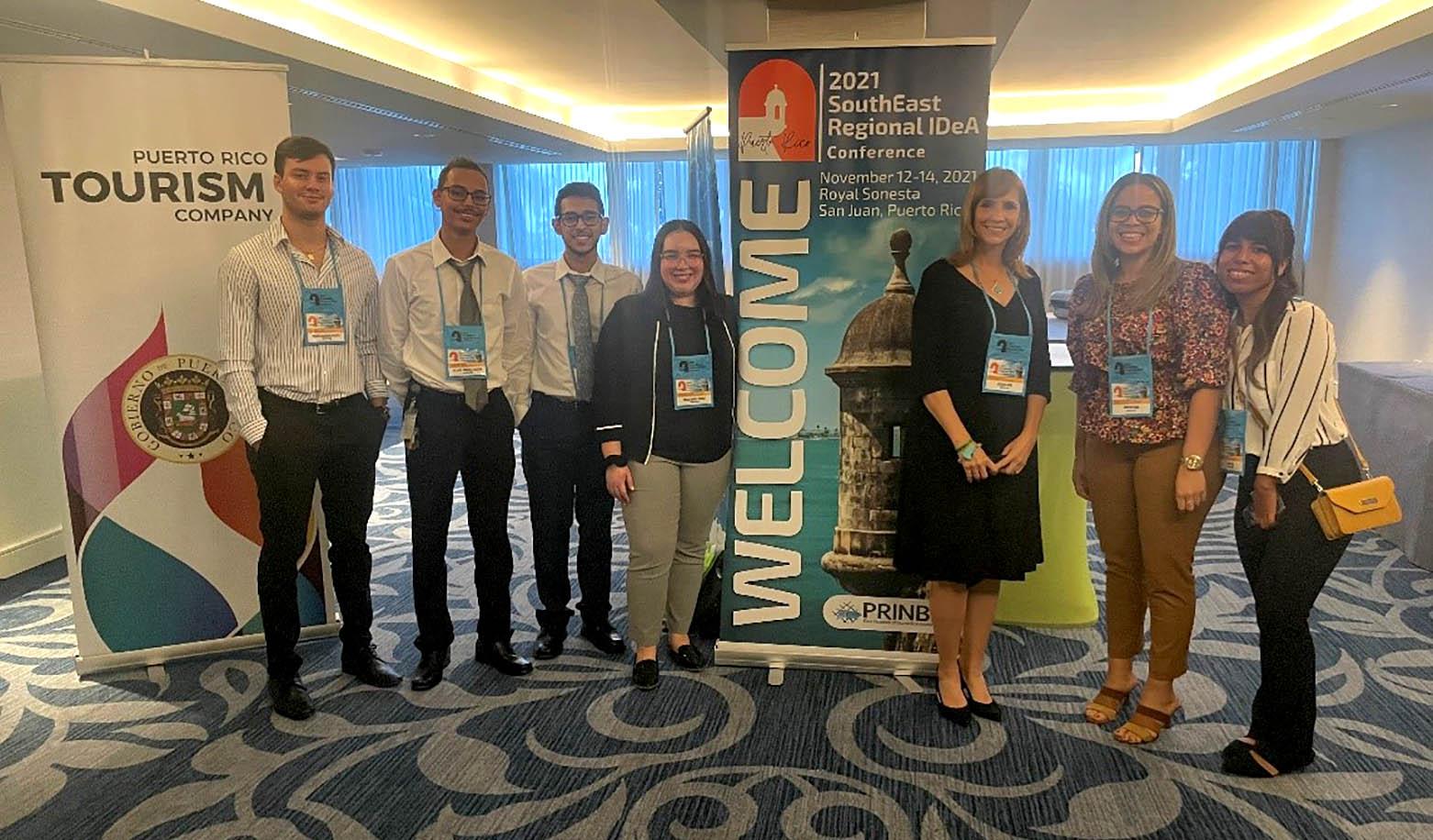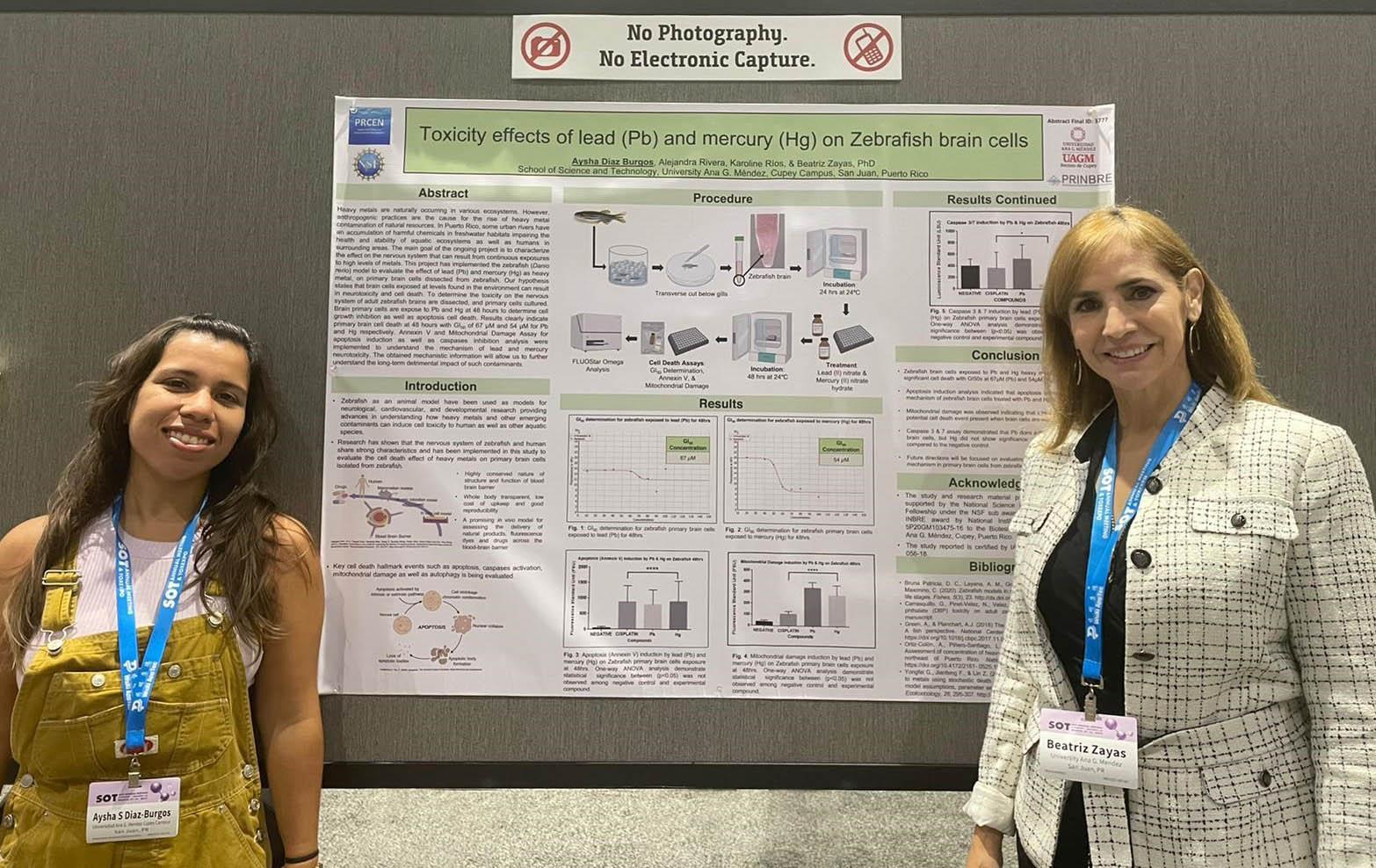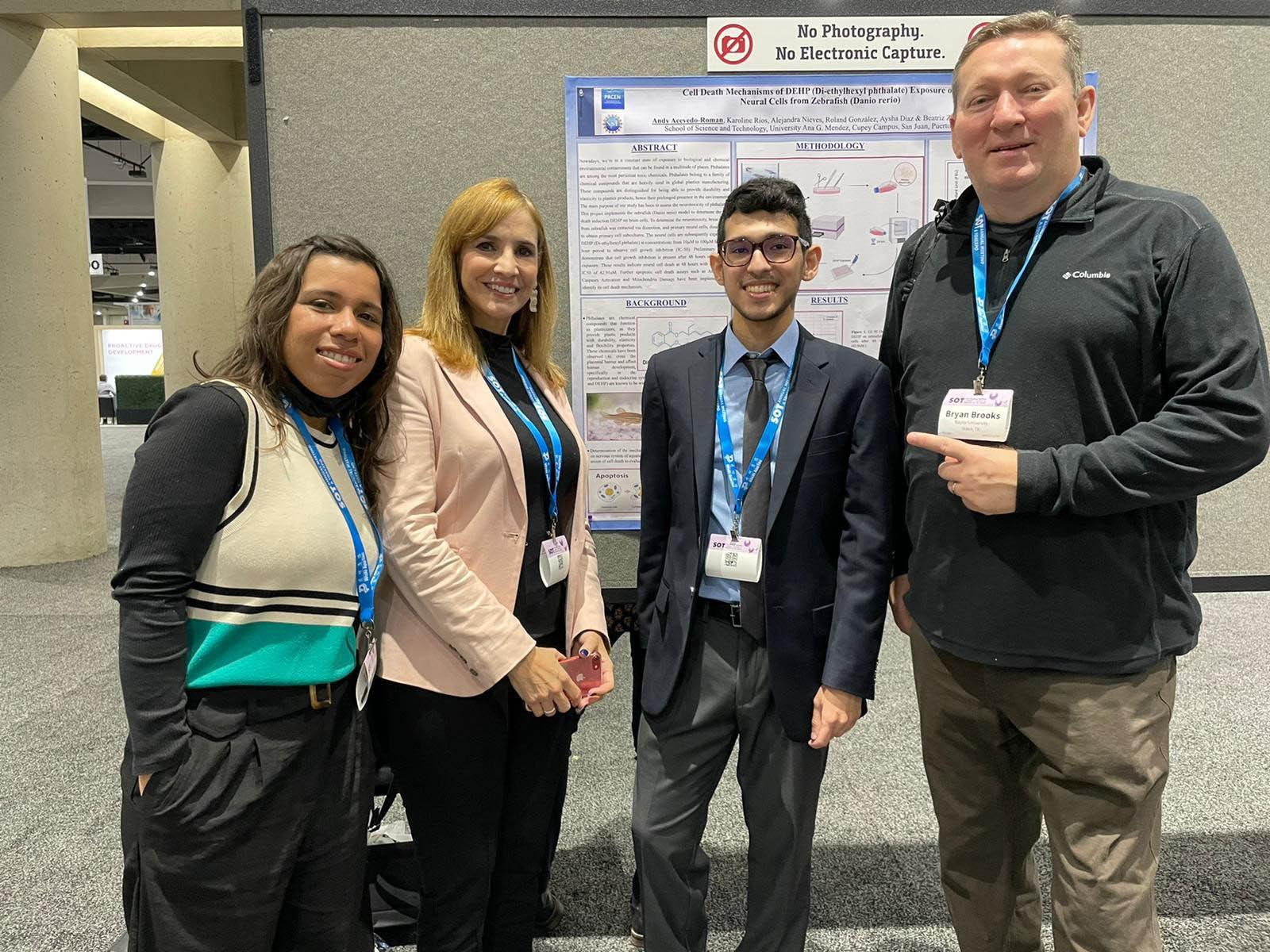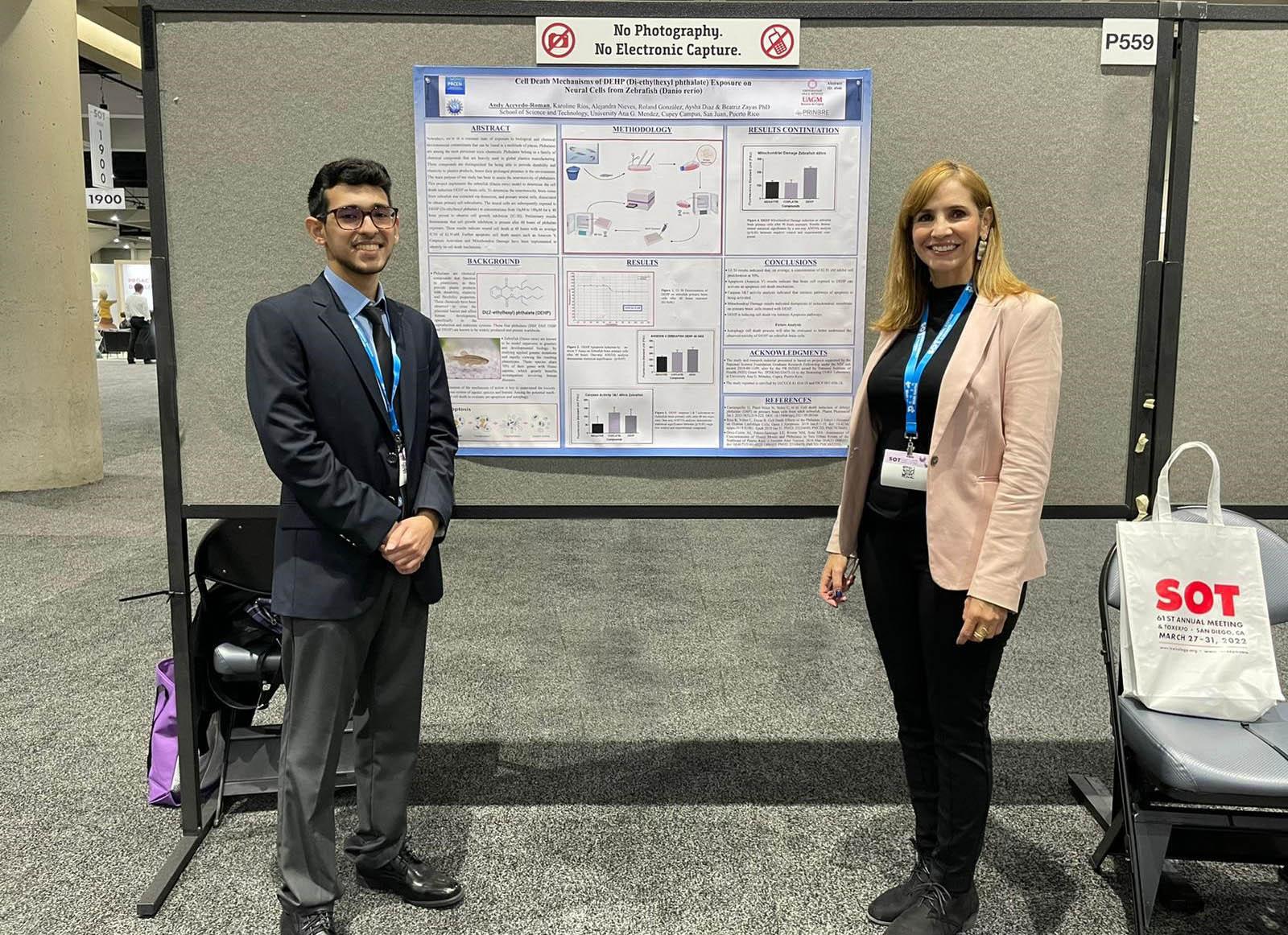ChEMTox Laboratory
About Us - ChEMTox Laboratory
Chemical Environmental and Molecular Toxicology Lab
The ChEMTox laboratory is part of the School of Science and Technology at the Cupey Campus of Universidad Ana G. Méndez (UAGM). Our facility is located in the Jose F. Mendez Building, Room 125 (First floor). The ChEMTox laboratory supports graduate research and provides valuable research experience for selected undergraduate science students. Our students participate on research projects related to anti-cancer drug development as well as projects in the field of environmental agents with toxicological impact. We implement in-vitro molecular toxicology techniques applying human cancer cells in cultures. We have also developed a new line of research with Zebrafish as an animal model for biomedical research.
In addition to the ongoing research projects, the laboratory offers analytical and technical support to scientists at UAGM, and other academic institutions as an In-vitro biotesting Core laboratory, supported in part by the PR-INBRE project financed by the National Institute of Health. For more information about the In-vitro biotesting Core see attached promo flyer and visit the PR-INBRE site at http://inbre.hpcf.upr.edu/.
Contact Us
- Beatriz Zayas, PhD, MS
Lab Director
787-766-1717 ext. 6462 or 6460
bzayas@uagm.edu
- Karoline Rios, BS, MSEM
Research Associate
787-766-1717 ext. 6462
karios@uagm.edu
By Mail
- ChEMTOX Laboratory
Universidad Ana G Méndez (UAGM)
P.O. Box 21150
San Juan, Puerto Rico
00928-1150
Message from Director

Welcome to the Chemical, Environmental and Molecular Toxicology Laboratory (ChEMTox Lab). We are a very active research laboratory that implement toxicology related research as well as a training place for graduate and undergraduate student interested on gaining research experience that can be applied to the biomedical or environmental toxicology fields.
The ChEMTox facilities at Universidad Ana G. Méndez, Recinto de Cupey was inaugurated on December 2005 and has been developed thanks to the financial support from the National Institute of Environmental Health Sciences (NIEHS), the National Institute of Health (NIH) and Universidad Metropolitana now Universidad Ana G. Méndez, in Cupey. The development of the laboratory represents a key step in the transformation of Universidad Ana G. Méndez, from a primary teaching institution to a teaching-research oriented institution.
The ChEMTox hosts research projects in drug development as well as environmental toxicology. We apply molecular toxicology methods such as in vitro human cell culture assays. More recently we have implemented a novel zebrafish primary cell culture system by dissection of zebrafish brain tissue. It is important to indicate that all our projects comply with the UAGM research regulatory offices.
Drug Development Research
In terms of drug development our group focuses on characterizing the therapeutic potential of novel compounds designed by synthetic or medicinal chemist such as Dr. Osvaldo Cox and other medicinal chemists in Puerto Rico or abroad. Many of our NIH funded project target on drug development that can be applied to cancer treatment or detection. With that purpose we test determining the anti-cancer potential of novel compounds or natural products. A key aspect of such determination is identifying the capacity of these compounds to inhibit the growth of cancer cells in vitro. Also, the interaction of such potential anti-cancer agents with cellular organelles such as mitochondria and DNA. In this context, human tumor and normal cells are treated in culture and their cytotoxicity and cell death mechanism (apoptosis and autophagy) are determined.
The developments of diagnostics markers are also explored at our laboratory as part of the drug development component. Findings in this area have generated multiple scientific publications and four patents for novel fluorescent markers. Currently these patents can be licensed by companies interested in cancer markers.

Environmental Toxicology Research
Understanding the negative effect of environmental agents on human health and other species is a key component of our research. Among many environmental contaminants with human health impact phthalates, polycyclic aromatic hydrocarbons and metals are studied in our laboratory. The presence of phthalates as plasticizer on pharmaceutical products as well as in aquatic environments requires serious attention. Phthalates are compounds widely used in the manufacturing industry and has been associate with multiple adverse health effects to human. Among the family of phthalates many well used for pharmaceutical products. Limited information however has been generated on the effect of DBP on the nervous system. The objective of our ongoing research projects is to determine their neurotoxicity potential applying the zebrafish model as an early stage- screening tool.
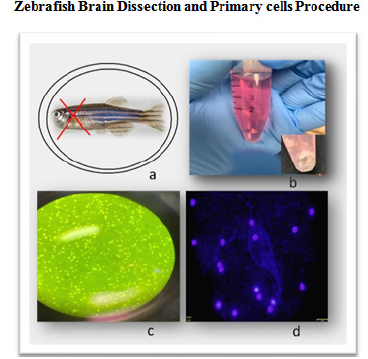
Laboratory - ChEMTox Laboratory
School of Science and Technology

Laboratory Equipment
The laboratory counts with multiple instrumentations that can be used by collaborators researchers as well.
FluoStar OMEGA (BMG LABTECH):
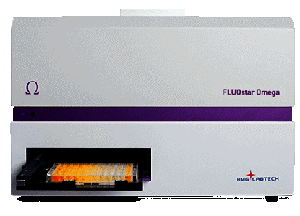
The FLUOstar® Omega is a multi-mode microplate reader with six detection modes. It utilizes an ultra-fast UV/vis spectrometer or filters for absorbance as well as highly sensitive filters for all other detection modes. The FLUOstar Omega is the ideal plate reader for life science applications.
For more information: https://www.bmglabtech.com/fluostar-omega/
Protein Simple a Biotechne Brand Jess:
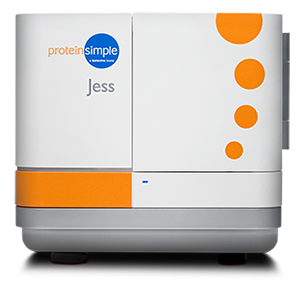
Jess automates traditional Western blotting while maximizing multiplexing with multiple detection channels. Automation of protein separation and immunodetection eliminates many of the tedious, error-prone steps of traditional Western blotting which limit data quality.For more information: https://www.proteinsimple.com/jess.html
Nucleocounter NC-3000 (Chemometec)
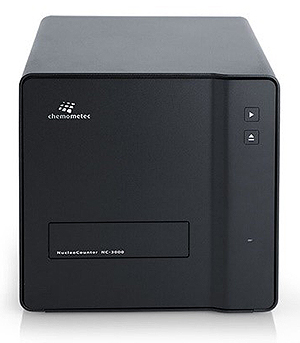
The NucleoCounter® NC-3000™ advanced image cytometer utilizes fluorescence imaging to characterize cell properties. The instrument performs high-speed plug-and-play analytical assays of mammalian, yeast, and insect cells.
For more information: https://bit.ly/3N2Pu74
UPLC-Mass Spectrometer
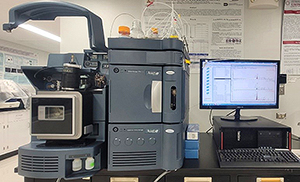
Waters UPLC Acquity H Class. With industry-leading separations performance, the ACQUITY UPLC H CLASS provides new possibilities of maximizing the resolution and sensitivity of your methods; enhancing the characterization of samples, while improving productivity to advance the science of your laboratory/
Olympus FSX100 Inverted Microscope
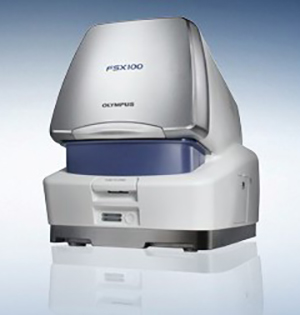
The FSX100 all-in-one microscope provides a compact, innovative plug-and-play solution for bright field, phase contrast and fluorescence microscopy. The FSX100 combines the highest quality, state-of-the-art hardware and smart and intuitive user-friendly software that guides the user to brilliant images.
For more information: https://bit.ly/3whKhkX
BioLog System
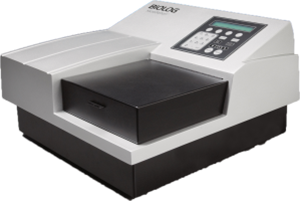
Biolog’s advanced phenotypic technology provides valuable information on the properties of strains, in addition to a species-level identification.
For more information: https://bit.ly/3MZMyIc
Laboratory Members
- Beatriz Zayas PhD, MS
Principal Investigator and ChEMTox Lab Director
bzayas@uagm.edu
- Karoline Rios Rodríguez MSEM, BS
Research Associate
karios@uagm.edu
Current Lab Students
- Fatima Hernandez
- Kianni Escalera
- Jazmin Isaac
- Luisa Torres
Former Lab members:
- Christian Vélez Gerena, MSEM
Researcher at United States Department of Agriculture (USDA)
Ames, IA, USA
- Aysha Diaz BS, MSEM
- Andy Acevedo, BS
Research Assistant
- Alejandra Rivera, BS
Doctoral Student
- Roland Gonzalez, BS
Doctoral Student
- Nicole Davila, BS
Doctoral Student
- Miguel Calderon, BS
- Gloricelys Rivera, PhD
- Marcos Rodriguez, MS
- Gloria Carrasquillo, MSEM
University of Puerto Rico, Medical Science Campus
San Juan, PR
- Luis M. Ortiz-Jordan, MSEM
UF Scripps Biomedical Research, University of Florida
Research Associate II
North Palm Beach, FL, USA
- Naysha Pinet
University of Illinois, Chicago
PhD student in Chemistry
Chicago, IL
- Javier Brunet,
Medical Student
- Alondra Báez, MPH
Center Disease Control (CDC), Region: Puerto Rico
San Juan, PR
- Tanya Escalera
Ponce Health, Sciences University
Graduate Student
- Carlos A. Rosado-Berrios, PhD
Texas A&M University
College Station, TX
- Jessica Soto Hernández, MSEM
US Environmental Protection Agency (EPA)
Washington DC, USA
- Vivian Lebron, MS
- Denisse Molina, MS
- Luis Colon, MS
- Maria Terron, PhD
- Jose Marengo, MS
- Sujey Carro, PhD
- Luz Vanesa Arroyo, PhD
Awarded Us Patents - ChEMTox Laboratory
School of Science and Technology

Five patents have been awarded to Dr. Beatriz Zayas and Dr. Osvaldo Cox for the development of organic molecules with biological activities such as: Cancer markers, bacterial staining, or as anti-cancer agents.
- April 2022 | Patent 5- USPO 11,311,531 (April 26, 2022). Tittle: Method for producing benzazoloquinolium (BQs) salts and using the biological activity of the composition.
- Dec 2020 | Patent 4- US USPO 10,624,885B2 (April 21, 2020). Title: Method for producing benzazoloquinolium (BQs) salts and using the biological activity of the composition.
- Feb 2018 | Patent 3- Cox, O. and Zayas B. USPO US9889128B2 (Feb 13, 2018). “Method for producing benzazoloquinolium (BQs) salts, using the composition as cellular markers, and using the biological activity of the composition.
- March 2015 | Patent 2- Zayas, B. and Cox, O. “Method for producing benzazoloquinolium (BQs) salts and using the biological activity of the composition”, US patent # US9,085,574B2, (July 21, 2015).
- Nov 2012 | Patent 1- Zayas, B. and Cox, O. USPO granted Patent (US 8,124, 770 B2). “Fluorescent Cellular Markers”. Also protected in China. China Patent (CN): CN201080021846.3. Granted April 29, 2015. “Fluorescent Cellular Markers”.
Publications - ChEMTox Laboratory
School of Science and Technology

- Carrasquillo G, Pinet-Velez N, Velez C, et al. Cell death induction of dibutyl phthalate (DBP) on primary brain cells from adult zebrafish. Pharm Pharmacol Int J. 2021;9(5):219-225. DOI: 10.15406/ppij.2021.09.00348
- Zayas B, Lebron V, Vélez C, et al. Novel NBQ-48 as marker of hypoxic cells in 2D and 3D colon cancer cells. J Cancer Prev Curr Res. 2020;11(1):13-18. DOI:10.15406/jcpcr.2020.11.00417
- Lafontaine-Cruz, R. E., Velez, C., & Ajay, K. (2020, October 28). Optimizacion de la Sintesis de AP-404 Utilizando Quimica Verde. Perspectivas, 8(69), 69-85. https://documento.uagm.edu/cupey/perspectivas/p_perspectivas_8_2020_69-85.pdf
- Ortiz-Jordan, L. M., Velez-Gerena, C., Soto-Nieves, N., Cox-Rosario, O., & Zayas-Rivera, B. (2020, October 28). Comparison of the toxicity of NBQ 234 TOM and NBQ 345 TOM on COLO 205 cancer cells and its fluorescent emission under hypoxic versus aerobic environments. Perspectivas, 8, 86-103. https://documento.uagm.edu/cupey/perspectivas/p_perspectivas_8_2020_86-103.pdf.
- Rios-Agosto, A. J., Velez-Gerena, C., Zayas, B., & Kumar, A. (2020, October 28). Identification of Antibiotics as Toxic Contaminants at Surface Water and Filtration Plant in the Northern Area of Puerto Rico. Perspectivas, 8(33), 33-47. https://documento.uagm.edu/cupey/perspectivas/p_perspectivas_8_2020_33-47.pdf
- Ocasio-Malavé C., Donate MJ., Sánchez M.M., et all (2019). Synthesis of novel 4-Boc-piperidone chalcones and evaluation of their cytotoxic activity against highly-metastatic cancer cells. September 2019Bioorganic & Medicinal Chemistry Letters DOI: 10.1016/j.bmcl.2019.126760.
- Rios, K., Vélez, C. and Zayas, B. (2019) Cell Death Effects of the Phthalate 2-Ethyl-1-Hexanol on Hu-man Linfoblast Cells. Open Journal of Apoptosis, 8, 1-15. https://doi.org/10.4236/ojapo.2019.81001 (PDF) Cell Death Effects of the Phthalate 2-Ethyl-1-Hexanol on Human Linfoblast Cells. Available from: https://www.researchgate.net/publication/334766574_Cell_Death_Effects_of_the_Phthalate_2-Ethyl-1-Hexanol_on_Human_Linfoblast_Cells [accessed Nov 07 2019].
- Vélez C., Soto J., Ríos K., Silva L., Hernandez W., Rivera LA, Ortiz-Colón A.I, Osvaldo Cox, Zayas B. (2017). Toxicity and Apoptosis Related Effects of Benzimidazo [3, 2-α] Quinolinium Salts Upon Human Lymphoma Cell. The open medicinal chemistry journal, 2017.
- Sanabria-Ríos, D. J.; Rivera-Torres, Y., Rosario, J.; Ríos, C.; Gutierrez, R.; Carballeira, N. M.; Vélez, C.;Zayas, B.; Álvarez-Colón, F.; Ortiz-Soto, G.; Serrano, V.; Altieri-Rivera, J.; Ríos-Olivares, E.; Rodríguez, J. W. (2015). Synthesis of novel C5-curcuminoid-fatty acid conjugates and mechanistic investigation of their anticancer activity. Bioorg Med Chem Lett. 2015;25(10):2174-80. doi: 10.1016/j.bmcl.2015.03.065. Epub 2015 Mar 31.
- Rodríguez-Torres, M. R., Vélez, C., Arslan, Z., Gonzalez-Vega, M. N., Beltran-Huarac, J., Morell, G., Zayas, B., Primera-Pedrozo, O. M. (2015). Optimization, characterization of direct water synthesis of cadmium selenide quantum dots and cytocompatibility for colo-205 cells. J Nanopart Res (2015) 17:266 DOI 10.1007/s11051-015-3064-8.
- Otero M., Zayas B., Miranda E., Velez C., Hernandez W.J., & Osvaldo Cox (2015). Immunomodulatory response of the unnatural alkaloid, 3-amino-7-benzylbenzimidazo[3,2-a]quinolinium chloride (ABQ-48) and 3-nitro-7-benzybenzylbenzimidazo[3,2-a]quinolinium chloride (NBQ-48). J Cancer Res Therap Oncol 2013 | Vol 2: 403 JCRTO. Open Access, 2015.
- Soto, K.T.; Guzmán-Blas, R.; Fachini, E.R.; Larios, E.; Valentín, L.; Zayas, B.; José-Yacamán, M.; Cabrera, C.R., “Highly Organized Nanofiber Formation from Zero Valent Iron Nanoparticles after Cadmium Water Remediation”, RCS Advances 2015, 5, 2777-2784. DOI: 10.1039/C4RA13267.
- Silva-Torres LA, Vélez C, Zayas B (2015) Xylazine and Its Speedball Combination: Induction of Apoptosis by Intrinsic and Extrinsic Pathway in Human Umbilical Vein Endothelial Cells. J Subst. Abuse Alcohol 3(1): 1024.
- Vélez C., Zayas B. and Kumar A (2014). Biological activity of N-Hydroxyethyl-4-aza-2,3-didehyropodophyllotoxin derivatives upon colorectal adenocarcinoma cells. Open Journal of Medicinal Chemistry (OJMC), Vol.4, 1-11. Laboratory of Synthetic Chemistry, SAIC-Frederick Inc., Frederick National Laboratory for Cancer Research, Frederick, USA School of Environmental Affairs, Universidad Metropolitana, San Juan, USA
- Cox O., Vélez C., Kumar V., Malhotra S., Rivera L., Hernandez W., Martínez J. Cordero M. and Zayas B (2014). Synthesis of and Biological Study of 7-Benzyl-3-aminobenzimidazo[3,2-a]quinolinium Chloride (ABQ-48: NSC D-763307) and 7-benzyl-3-nitrobenzimidazo[3,2-a] quinolinium Chloride (NBQ 48: NSC D-763303). Current Bioactive Compounds 2014, 10, 286-291.
- Silva-Torres L., Veléz C., Álvarez L., and Zayas B., (2014). Xylazine as a Drug of Abuse and Its Effects on the Generation of Reactive Species and DNA Damage on Human Umbilical Vein Endothelial Cells. Journal of Toxicology Volume 2014, Article ID 492609, 8 pages. http://dx.doi.org/10.1155/2014/492609.
- Silva-Torres L.A., Vélez C., Vargas-Vidot J., Ortiz J.G and Zayas B., (2014). Toxic Effects of Xylazine on Endothelial Cells in Combination with Cocaine and Heroin. Toxicology in Vitro 28(7):1312-1319.DOI: 10.1016/j.tiv.2014.06.013
- Vélez C., Cox O., Rosado-Berrios C., Molina D., Arroyo L., Carro S., Kumar V., Malhotra S., Cordero M., and Zayas B. (2013). Novel nitrobenzazolo[3,2-a]quinolinium salts induce cell death through a mechanism involving DNA damage, cell cycle changes, and mitochondrial permeabilization. Open Journal of Apoptosis, Vol.2 No.2. Paper ID 30466.
- Soto K., Zayas B., Cox O., and Cabrera C. (2012). Cadmium reduction with nanoparticles of iron in heavy metals remediation. [Reducción de Cadmio con nanopartículas de hierro cerro valente para la remediación de metales pesados]. Perspectivas en Asuntos Ambientales,1(1),19-20.Soto, K.,
- Rosado C., Velez C. and Zayas B. (2011). Mitochondrial Permeability and Toxicity of Di ethylhexyl and Mono ethylhexyl Phthalates on TK6 Human Lymphoblasts Cells. Toxicology in Vitro 25 2010–2016.
- Zayas B, Beyley J, Terron M, Cordero M, Hernandez W, Alegría AE, Cox O., (2007). Comparison of the nucleic acid covalent binding capacity of two nitro-substituted benzazolo[3,2-a]quinolinium salts upon enzymatic reduction. Toxicol In Vitro. 21(6):1155-64. Epub 2007 Mar13.
Training Activities and Conferences
Biotesting Core Facility Present and Past Collaborations:
- Dr. Osvaldo Cox (UAGM Cupey)
- Dr. Ajay Kumar (UAGM Cupey)
- Dr. Maria C. Ortiz (UAGM-Cupey)
- Mr. Alex J. Rios, MSEM (UAGM-Cupey)
- Dr. David Sanabria (Inter- Metro)
- Dr. Mirna Rivera (UPR-Humacao)
- Dr. Celine Cassé (UPR-Mayaguez)
- Dr. Joseph Bloom (UPR- Escuela de Farmacia RCM)
- Dr. Claudia Ospina (Interamerican University – Bayamón Campus)
- Dr. Noemí Soto (Universidad Sagrado Corazón)
Próximos eventos
-
23 de octubre de 2025 6:00 pm 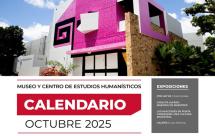 Académica
AcadémicaTaller Mentalidad en calma: estrategias para gestionar ansiedad y estrés académico
Leer más -
28 de octubre de 2025 8:00 am 
-
29 de octubre de 2025 11:30 am 
-
30 de octubre de 2025 8:00 am 
-
30 de octubre de 2025 5:30 pm 
-
6 de noviembre de 2025 5:00 pm 
-
20 de enero de 2026 7:00 am 
